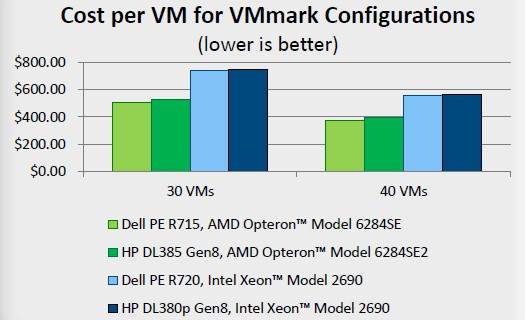While Intel has been pushing into new territory with their CPUs by including internal memory controllers etc., AMD has been relying on innovation from the original Opteron and has not been able to break out of that rut. Intel is even pushing into storage, switching and more with their Atom CPUs. It is like a return to the mid-90s when Intel was king in the enterprise and AMD was an afterthought.
Still at VMWorld AMD President and General Manager of AMD Server business unit, Suresh Gopalakrishnan, was there to tell anyone that would listen about what AMD’s Opterons can do for you now and what they want them to do in the future. Interestingly enough Gopalakrisnan comes from a RISC background, which is a direction we mentioned that AMD might look to move into for their server CPUs especially since they are looking to integrate ARM Cortex CPUs into their new processors in the future (ARM components are RISC based). The move would be in line with that, but Gopalakrishnan also brings networking experience into the game which is a vital component for the server market especially in the virtualization segment where you have to make sure your systems can properly load balance between multiple host nodes and storage. We have watched as VMware environments crumble due to improperly setup networks for storage and hosts. It really looks like AMD’s new server boss has the talent to do the job, but will he get the chance?
One thing that worries us about AMD is their insistence on what they call the needs of future systems. This very ambiguous term seems to indicate that AMD might not be able to fix things to compete on the same ground as Intel, but will try to claim a new space that they invent to make a stand like they did in the mid and late 90s when AMD proclaimed the K62 and K6III best for business. Are we going to see AMD try to pull this again? It seems they might as AMD also tried to push some less than realistic numbers on VMWorld attendees. This was in the form of an info-graphic that tried to claim that a dual Intel Xeon E5-2690 with 256BG of memory was not as good of a value for VMware as AMD was. It is important to note that AMD showed a system that had one half the memory of the Intel system. AMD did not do the comparisons themselves, but used ones given to them from HP and Dell, but since we are guessing that AMD knew the configurations were not matched this is still on them to make sure they present the right data. AMD should know that IT shops order servers for their VM environments by finding the sweet spot in terms of price per module and performance overall; to present a single representation like this is bad form from Dell, HP, and yes AMD.
The comparison was not only odd because the AMD systems had half the amount of memory, but because working backwards it looks like Dell and HP might have chosen to max out the available memory slots on the Intel system with the most expensive RAM available the 32GB RDIMM modules at $1749 per module. This would have artificially pushed the Intel system to over $20,000 and accounted for the large difference in cost per VM (close to $700 per VM). Now if we work backwards and use 16GB modules at $365 per unit we end up with a much lower cost per VM at closer to $500 per VM and the fun does not stop there. At our minimum (looking solely at the server side computing power) we can get the same server down quite a bit in price by plying with the types of modules that we put in and by matching the AMD system for the same memory size 128GB. If we drop all the way down to using 8GB modules at $164 each then we are all the way down to under $400 per VM.
AMD went on to show their own data for more cost per VM comparisons, but they really did not do much to help their cause as they used models from two different manufacturers for this comparison. Simply put, AMD needs to find a way to show apples-to-apples performance on the same systems with exactly the same specifications and then show us the costs of each of these using different VMware systems. They just do not have the reputation for performance that they did when the Opteron was new and they cannot simply start to claim a price advantage based on someone else’s data or in a mix and match configuration.
We think that AMD does have the right idea moving forward with server and desktop CPUs that can shift loads where they can get the best performance (using a CPU core or a GPU core), but they cannot start off with a marketing message that is both inaccurate and more than a little disingenuous. Some may see a ray of light in their new engineering team for their server platform, but until they can come out with something more than slides and talk of value it is unlikely to sway many to their side.
Source for AMD slides TheRegister
Disucss this in our Forum




